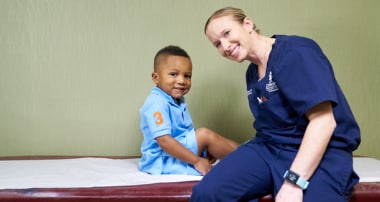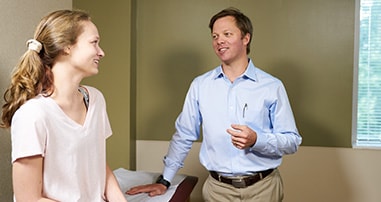Hip Fractures
Children’s bones are very strong, and hip fractures are quite rare. There are typically three circumstances in which a child can sustain a broken hip:
- A high-energy injury, such as a motor vehicle collision or being hit by a car, falling out of a tree or a collision during sports.
- A low-energy injury in which the bone fractures through a weak portion, usually a bone cyst.
- An injury through the growth plate where tendons and ligaments attached (this is known as an apophyseal avulsion fracture).
A common type of hip fracture occurs through a portion of the femur (thighbone) that has a rich blood supply. It typically occurs through a benign (noncancerous) bone cyst. These fractures are often fixed with a plate that is placed during surgery.
A less common hip fracture occurs near the head or neck of the femur. This is an emergency situation because the blood supply to the bone can be temporarily compromised. Some orthopedic experts believe that if the fracture is fixed early, it may help decrease the chance that the blood supply is lost from the bone permanently. A doctor will want to follow up with your child for at least 18 months after the fracture because it may take a long time for a loss of blood supply, also known as avascular necrosis, to occur and because it’s possible for a bone cyst to reoccur.
Apophyseal hip avulsion fractures occur where the tendon or ligament attaches to the bone. It is in the same location where athletes can experience pain from apophysitis (irritation from repetitive pulling) of the hip.
The injury occurs with a sudden contraction of the muscle, including activities like:
- Sprinting
- Hurdling
- Kicking
- Jumping
- Splits
Symptoms of a hip apophyseal avulsion fracture may include:
- Sudden onset of tenderness
- Swelling
- Pain with stretching the involved muscle
- Weakness and pain with active contraction of the involved muscle
- A limp, but can usually walk
At Children’s Healthcare of Atlanta, hip avulsion fractures are diagnosed through:
- Complete medical history and physical examination
- X-ray
Treatment for apophyseal hip avulsion fractures may include:
- Icing the injured area for 15 to 20 minutes during a three-hour span every day.
- Using crutches or a wheelchair, known as protected weight bearing.
- Participating in a physical therapy progressive program to help with recovery.
- Taking medication to help relieve pain (ibuprofen).
- Resting from the activity that is causing the pain and inflammation.
- Having surgery (rare but it may be needed to reattach the tendon).
Support on Facebook
Contact Us 404-255-1933

